“The small habits you make from today will create the big results you see tomorrow.” – James Clear
Once upon a time, a young man named John was struggling to build good habits. He wanted to be more productive, healthier, and happier, but he needed help to stick to new routines. One day, John was reading a book about self-improvement when he came across a story about a bamboo plant.
Bamboo plants are known for growing very quickly, but it takes four years to develop a root system. During those four years, all that is visible above ground is a tiny sprout. John realized that building good habits is like growing a bamboo plant. It takes time and effort to develop a strong foundation, but the results can be incredible once you do.
John decided to start small. He committed to working out for 20 minutes daily and reading one book a month. At first, it wasn’t easy to stick to his new habits, but he persevered. After a few weeks, John started to see results. He had more energy, was sleeping better, and felt more accomplished. He also realized that he was enjoying his new habits.
Over time, John added more good habits to his routine. He started eating healthier, meditating regularly, and spending more time with his loved ones. He also began to achieve his goals more quickly.
Introduction
Today’s book summary is like this story: how we can change our lives by changing small habits. Today, we will learn about “Tiny Habits” by BJ Fogg. There are many books on this topic, like The Power of Habit and Atomic Habits, but this book teaches you to make significant changes with small things related to your daily life, which you can do very quickly.
The Tiny Habits method is based on twenty years of research and Fogg’s experience training more than 40,000 people about habits. In this, you will learn how to feel good about your successes instead of feeling bad about your failures. This step-by-step guide will help you design habits, create positive emotions, and celebrate small achievements. Whether you want to lose weight, be stress-free, sleep better, or be more productive daily, the Tiny Habits method makes it easy to achieve by starting small.
We have divided this summary into five chapters to understand the book quickly. So, let’s start.
Chapter 1. Elements of Behaviour
A behaviour is formed when motivation, ability and sign come together. It is also called the Fog Behavior Model. Interestingly, the Fog Behavior Model applies to all behaviours, including the habits you are trying to change to become better.
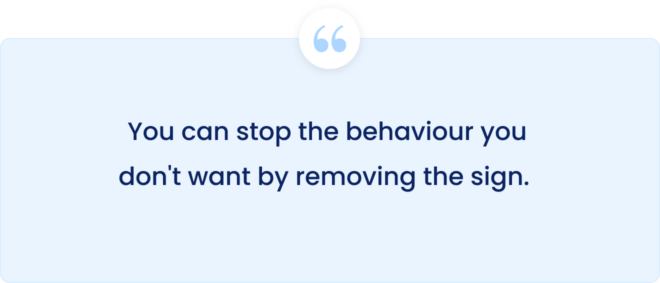
You can stop the behaviour you don’t want by removing the sign. It’s not always easy, but removing the signal is your best first step to preventing a behaviour from happening. The main thing is that the easier it is to perform a behaviour, the greater the chances it will become a habit.
And it is also used to break bad habits. Suppose you want to end the practice of watching TV. So it will be tough to see it when it is unplugged or in another room. Because now you have to carry it down the stairs and plug it in to watch.
Let’s say you’ve been struggling with your body weight for years. You may have been made fun of for being overweight. In such a situation, first, do not focus on weight loss. Create habits that are tied to something small. When you start doing that small thing, your motivation starts increasing. In this way, your willpower will strengthen by first building your skills.
We often want to adopt a new behaviour or change the current one, but we often need to get the desired success. For those situations, I have good news: The Behavior Design Set gives you specific steps to solve this simple problem.
Let’s say you want your employees to arrive on time for your weekly team meeting, but they consistently arrive a few minutes late. Many managers get upset with this behaviour, fine them or scold people who come late. So that they can motivate them to come on time next time; this also happens in our personal life. We want to adopt a specific behaviour but are unable to do so. So you can do this by adopting these steps.
- Create an anchor for that behaviour.
- Develop the ability to do that behaviour.
- Increase motivation to do it.
Start with a sign to solve the problem of being unable to adopt a behaviour for yourself or others. Ask employees who come late to meetings. Do you have any reminders to go to the discussion on time? Ask them to find a good reminder or sign if they don’t have one. With this, the problem can be solved quickly. Just design an excellent sign.
If this doesn’t work, move on to the next step. See if people have the ability to behave that way. Ask your late employee what makes it difficult for them to arrive at the meeting on time. Perhaps their last session ends at the same time as yours, so it takes time to freshen up and come. This tells you that it is a problem of ability, not motivation. Therefore, work on their abilities to make it easier to attend the meeting on time.
Most people believe that to perform any behaviour, you first need to pay attention to motivation. The first step is to create a sign or reminder; if this does not work, then build the ability, and if this also does not work, then move towards motivation. You can give some reward for motivation. But remember, motivation will help only for some time; in the long run, the first and second methods will work more effectively.
Let us understand this with an example. Suppose you asked your young daughter to buy religious books and posters on her way home from college. You think I have told her, so she will bring the sign when she comes. She comes home from college but still needs to take your poster board. You get upset and explain how much you need that poster board. Your daughter says, “Sorry”. I will bring it tomorrow.
But the next day, no poster board came. Like most normal people in this situation, you can get angry at her, punish her by not driving the car for the next few days, or scold her by saying that she can’t be trusted with things like this. She is very careless. Ultimately, you motivate her not to repeat this mistake next time through these three methods. But as you know, this behaviour will not have a good effect on your relationship.
Let’s repeat this story and imagine you can solve this problem. Don’t be upset when your daughter comes home without a poster board on the first day. Go into problem-solving mode and think, “Did you give her some hints to remind her to buy the poster board? No. You just thought she would remember, but she didn’t. So give her a hint to remember the next day.”
Ask her to make a reminder or a sign, like making a to-do list note on your daughter’s phone or calling her while coming back from college and reminding her. She will bring you a poster board with a smile when you implement this troubleshooting method in your behaviour the next day. If you apply this method, you’ll find that it helps you stop blaming yourself.
Let’s say you didn’t get up early this morning as expected. So, this method enables you to stop blaming yourself for your lack of willpower or motivation. Instead, set an alarm or similar reminder to wake up early or go to bed on time in the evening. This will help you know you have something to motivate you. What was it that triggered that?
What was making the behaviour challenging to do? You will often find that your lack of behaviour is not a motivation issue. You can easily do this by finding a good sign or making the behaviour more straightforward.
Chapter 2. Three ways to make behaviour easier
1. Increase your skills
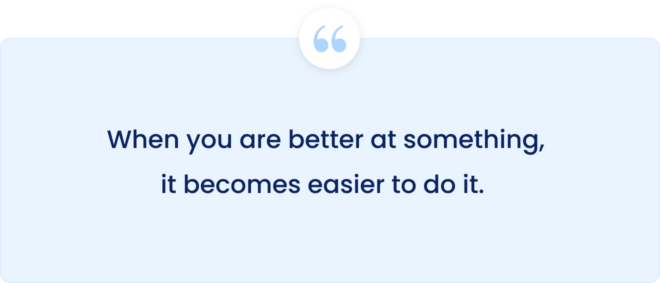
When you are better at something, it becomes easier to do it. Therefore, by developing SKILL, you can increase the capacity to do that habit. To improve your skills, do online research, ask for suggestions from a friend or take a related class and repeat that behaviour repeatedly.
If you want to develop the habit of keeping clean, read The Life-Changing Magic of Tidying Up, the world’s best-selling book that teaches you about cleanliness. With this, you will learn practical ways to keep your house clean. Thus, increasing your skills means hiring a voice coach who will tell you to do any task even when you don’t feel like it.
2. Arrange good tools and resources
To make your new behaviour comfortable, have as many necessary tools and resources as possible. Remember, it won’t become a habit if a behaviour frustrates you. Arranging the right tools to make your behaviour easier means making sure you feel like cooking, so that could be anything from a comfortable knife for the kitchen to more comfortable shoes for running in the morning.
The author’s friend Molly is an excellent example of how tools and resources can motivate change. Since Molly was ten years old, she struggled to maintain her healthy weight. And this problem continued till she was young because she overeats junk food. Although Mauli wanted to cook home-cooked food, preparing food took a lot of time and hassle, so she had to eat from outside.
One day, Molly went to a friend’s house and saw her using a tool with a flat frame and an adjustable blade. Her friend chopped whole carrots into a salad bowl in about ten seconds, with no wobbly cutting board or dull knives. It felt like magic to Molly. She asked her friend, “Wow! What is that thing? It was a mandolin. This tool made it easier for her to chop vegetables, so she cooked at home on holidays for the next few weeks and now cooks daily.
A year later, she told the author that she was happier, more energetic and more productive than ever. Most importantly, she now asks, “How can I make this easier? So that even when she lacks the motivation to cook, she still eats healthy home-cooked meals.”
You don’t have to buy fancy kitchen tools every time, but learn from Mauli and buy the necessary tools to make it easier as per your habit and adopt new things with a flexible mindset. This way, you can do the work more productively in less time. Due to this, it will become easier to do, the motivation to do it next time will increase, and by doing it again and again, that behaviour will become your habit.
3. Make Behavior Small
Making behaviour small is the basis of tiny habits. There is a surefire way to make any task more accessible, which means making a goal of completing a small part of your new habit while doing what you feel is just a little. I could have finished it now.
For example, if you want to walk three kilometres daily, your first step is to wear running shoes. That initial step becomes your small behaviour and begins your new habit. The purpose is to start with just one crucial step in achieving the desired behaviour.
Say to yourself: I don’t want to walk. I have to wear my shoes every day. Wearing those shoes will change your thinking. Suddenly, walking will seem more straightforward than it appeared before. Most days, you’ll head out the door and walk around your area after putting on your shoes. This is a way to turn small initial steps into big habits.
While doing this, remember, take your time to make this small behaviour big. If you wear shoes but don’t run someday, that’s okay, too. But remember to wear shoes every day. When this behaviour becomes comfortable, the behaviour moves towards walking, running, and so on, becoming comfortable with each habit. This will strengthen your confidence that you can always take action, no matter how your motivation fluctuates.
For example, the biggest problem for Sarika, one of the author’s students, was being unable to cook breakfast herself. He found it very difficult to do this. After taking the Tiny Habits course and learning about Starter Steps, Sarika decided to turn on the stovetop burner first thing in the morning.
That was her new habit. Although this was a tiny habit, it was a stepping stone towards cooking breakfast. That’s all she did for the first few days. She would leave the burner on for a few seconds, then turn it off. But she soon placed a pot on the burner. Then, once the pot was in there, she thought, why not boil water for the porridge?
Once the water started cooking, it seemed foolish not to add the porridge, and she made her breakfast most days by adding it. In this way, she became comfortable with each step and formed a new habit. But if she ever felt rushed or distracted, she would turn the burner on and off and complete that day’s task because the Starter Step was the only behaviour she had incorporated into her daily routine.
Starter Step is a mental motivation. Doing such a small step continuously keeps you motivated internally to do the next step. Because by consistently doing just one small behaviour, the momentum it creates in you often takes you to the next step with less friction. You have to remember this: don’t get demotivated by not being able to have any more significant habit other than your small habit.
You have to take responsibility for your starter behaviour, like lighting the burner, and you will be successful every time. Every time you do this, you keep that habit alive and create the possibility of moving forward.
For example, Sarika was surprised at how quickly her burner habit developed into multiple patterns, making it a habit to make a full breakfast. Motivated by her success, she also started making lunches and dinners. And within a few months, she moved beyond porridge and started making morning dosa with chutney.
Chapter 3. Identify your Anchors
Anchors mean some behaviour in your daily life immediately before or after which you will make your new desired habit. Your anchor should be something that happens in your life. Some people feel they do not know what work to do in their daily schedule; sometimes they do one thing and sometimes something else.
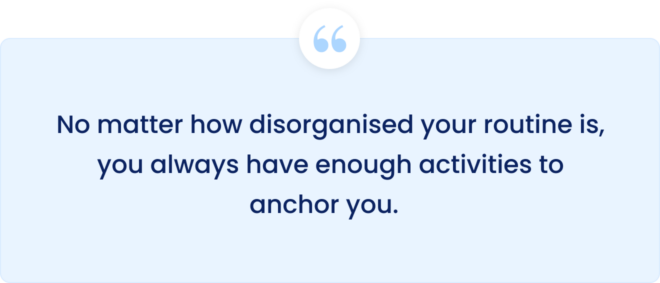
This situation may happen to you, too. No matter how disorganized your routine is, you always have enough activities to anchor you. Try these anchors as much as possible in the morning. The author found in the research that our routine is usually more fixed in the morning; at this time, most of the things happen that we typically do daily. Therefore, morning is like fertile soil for developing new habits.
Our schedules easily get disturbed as the day progresses. And once one program is broken, the other also gets broken. For example, due to starting work late, more focus goes on work, and habits made to stay healthy during the day are avoided. Coming back late from the office, you take pizza instead of cooking dinner. In this way, you can make your habit of using anchors in your morning, afternoon and evening.
Do this in your morning routines.
- I’ll do it after my feet hit the ground in the morning.
- After sitting on the bed, I will do this.
- After I turn off my alarm, I’ll do this.
- After I go to the toilet, I will do this.
- After I flush the bathroom, I will do this.
- After I turn on the shower, I’ll do this.
- After I brush my teeth, I’ll do this.
- After I brush my hair, I’ll do this.
- After I make my bed, I’ll do this.
- After tying my shoes, I’ll do this.
- After I turn on the coffee maker, I’ll do this.
- After pouring myself a cup of coffee, I’ll do it.
- After I put my dishes in the dishwasher, I’ll do this.
- After feeding the dog, I will do this.
- After I put the key in the ignition of my car, I’ll do this.
Do this in your midday or afternoon routine:
- After hearing my phone ring, I’ll do it.
- After I hang up the phone, I’ll do this.
- After having a cup of coffee, I will do this.
- After clearing my inbox, I’ll do this.
- After coming from the bathroom, I will do this.
Do this in evening routines:
- When I reach my doorstep after office, I will do this.
- After I put my bag down, I’ll do this.
- After I sit down to eat, I will eat this.
- After I put my dinner utensils in the dishwasher, I’ll do this.
- After I turn on the dishwasher, I’ll do this.
- After I turn off the TV, I’ll do this.
- After I put my head on the pillow, I’ll do it.
In this way, find anchors according to your schedule. And after that anchor, do a small behaviour related to your desired habit. Once you have several anchors, look carefully at the new pattern you want to develop to associate your new routine with the most suitable anchor.
Chapter 4. Emotions Create Habits
There is a direct relationship between how you feel when you perform a behaviour and your likelihood of repeating that behaviour in the future.
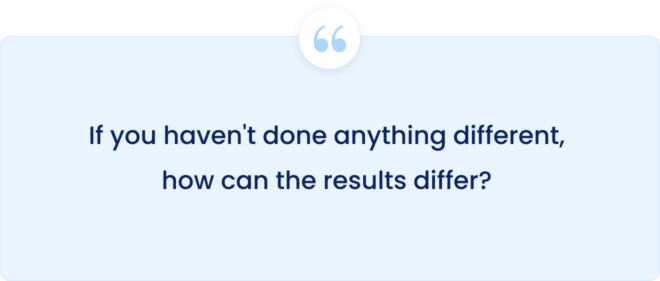
For a long time, people have believed in the old myth that repeating things creates habits, but while doing so, remember that this is just recycling old thoughts. If you haven’t done anything different, how can the results differ?
Keep this in mind when you design your behaviour to form a habit. Just think about how Instagram and Snapchat take advantage of this. Once you’ve taken a photo, the app makes it easy to use filters. As you apply different filters, you see your photo magically transform before your eyes, and the photo is no longer just a photo.
You feel like you are sharing a fantastic feeling and moment. When this happens, your brain releases dopamine, and you look for opportunities to use Instagram or Snapchat again because it feels good.
Regarding behaviour, decision and habit are opposites of each other. The decision requires thinking, not habits. You can decide what to wear when you go to work every morning. But most people must decide whether to take their phone while leaving the house.
They take it with them without thinking. Because the phone is connected to their emotions, people feel good about it without thinking. In this way, it becomes their habit to keep the phone with them and keep looking at it occasionally.
The entire process of habit formation is precisely the same for good and bad habits. For example, if an announcement is made today that eating cake is prohibited after 2 o’clock tonight because it is not suitable for health. So your brain won’t care because it still wants the pleasure of eating the cake.
Similarly, many behaviour we do not like or know are unsuitable for us, but we do not stop doing them because they are connected to our emotions. Like using mobile phones, playing video games, etc. Your brain’s reward system is more influenced by feelings and less by what society calls “good” and “bad.”
As humans, we are deeply connected to emotions, so most of our habits are a mix, some of which we want and a lot of which we don’t. The good news is that you can control it. We already have the option to use our brains to feel good and change behaviour. You can adopt your desired habit and feel like a winner.
Chapter 5. Use Celebration to Build Habits
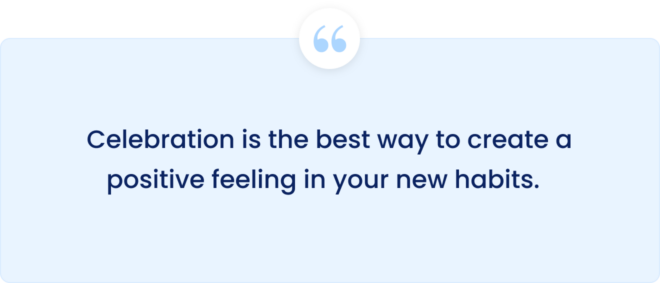
Celebration is the best way to create a positive feeling in your new habits. It is available to everyone. Celebration teaches us how to be good to ourselves. But before mixing habit celebration techniques with everything you’ve heard about celebration, understand this.
Celebration activates your desire for reward. Let’s say you commit to running every day for two weeks; then, at the end of those two weeks, you reward yourself with a massage. This reward is good for you. Because this massage will benefit you in the future, here, your massage will become a motivation, not a reward.
Simply put, the reward should be a good experience directly related to your behaviour that increases the chance of that behaviour occurring again. Give a tip either during your behaviour or as soon as possible after it to improve your ability to do that behaviour again, because at that time, the happy hormone called dopamine is released very rapidly in our brain. This means that to form a habit, you have to develop those good feelings quickly.
A natural and deeply felt celebration will give you the superpowers of forming habits. If you need clarification about what might work for you, put yourself in these situations and see how you respond. This will let you know about your natural ways of celebrating.
Use that natural process to add a spark to your new habits. (When you read these situations, don’t think or analyze too much. Just allow yourself to respond.
Dream job: You apply for your dream job in your favourite company. Reach the last interview round. The hiring manager says, “We will email you our decision. The next day, you get an email from the manager with the joining letter. What do you do at that moment?
Office scenario: Imagine yourself sitting in the office. You have a piece of paper, and the dustbin is in the room corner. You decide to wrap the paper and throw it in the dustbin. You throw the paper with careful aim, and it falls straight into the dustbin. What do you do at that moment to celebrate your perfect shot?
Championship Scenario: Your favourite team is in the championship game. The scores of both groups are equal, and very little time is left. As soon as the time is up, your team wins by scoring. What do you do at that moment?
Have you found a way to celebrate that makes you feel sparkly? If not, it’s time to try some other celebration techniques. Here are some celebrations you can try. These include those you can do in the middle of a crowd or the privacy of your home.
- Say “Yes!”.
- Laugh openly.
- Listen to your favourite song.
- Dance.
- Clap your hands.
- Nod your head and celebrate.
- Congratulate yourself.
- Imagine the crowd clapping for you.
- Take a deep breath.
- Snap your fingers.
- Burn crackers.
- Look up and make a V with your arms.
- Smile and tell yourself, I got this.
Conclusion
Friends, let us repeat what we have learned so far so that it can be remembered easily.
1. To change an old bad habit, remove the associated sign. And in the same way, to adopt new behaviour, put up a sign reminding you to do it.
2. To change any behaviour, follow these three steps:
- Create an anchor for that behaviour.
- Develop the ability to do that behaviour.
- Increase motivation to do it.
3. To make any behaviour easier, follow these three methods:
- Enhance your skills. When you are better at something, it becomes easier to do it. Therefore, by developing SKILL, you can increase the capacity to do that habit.
- Arrange tools and resources.
- Make your behaviour as small as possible.
4. Another way to make the habit easier is scaling back. Just scale down the behaviour you want. For example, you want to develop the habit of reading books. So, the startup step will be just opening the book, and the scaling back will be just reading one paragraph.
5. Create anchors related to your habit. Anchor means some behaviour in your daily life immediately before or after which you will make your new desired habit. Your anchor should be something that happens in your life. I’ll do this after my feet hit the floor in the morning. After I sit up in bed, I’ll do this; After I turn off my alarm, I’ll do this; And so on.
6. Finally, celebrate even the most minor behaviour that has changed. And celebrate it as much as possible in your natural way of celebration. That behaviour will connect with your emotions, making it easier to do it repeatedly.
Tiny Habits Book Review
“Tiny Habits” by BJ Fogg is a game-changing book emphasizing the power of small, manageable habits in transforming behavior.
Fogg’s Behavior Model, comprising motivation, ability, and triggers, underscores the significance of starting with easy-to-adopt habits aligned with personal goals. The book challenges the conventional wisdom that motivation is the sole driver of change and stresses the importance of making habits enjoyable and stress-free.
Fogg advocates designing one’s environment to make desired behaviors more accessible. “Tiny Habits” offers a practical framework for sustainable personal growth, enabling individuals to incrementally build positive change by embracing small, easily integrated habits in their daily lives.
Thank You !
Contents

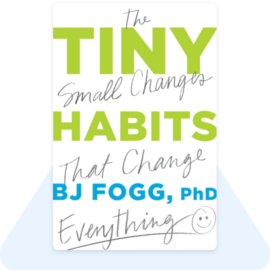
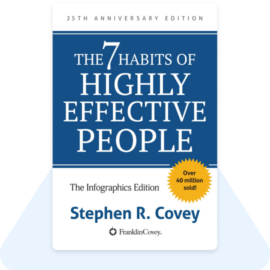
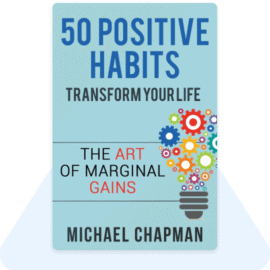
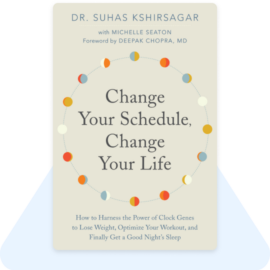
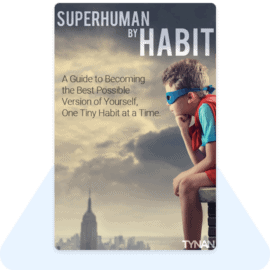
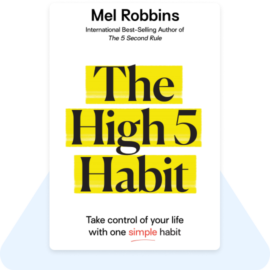
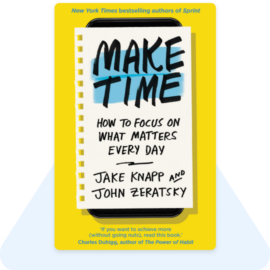

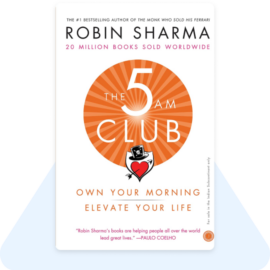

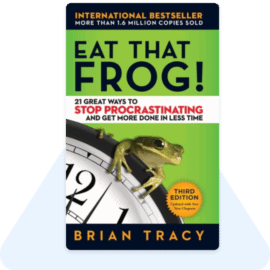

Thankz for the summary
Thanku so much sir
Celebration is the best way to create a positive feeling in new habbits…